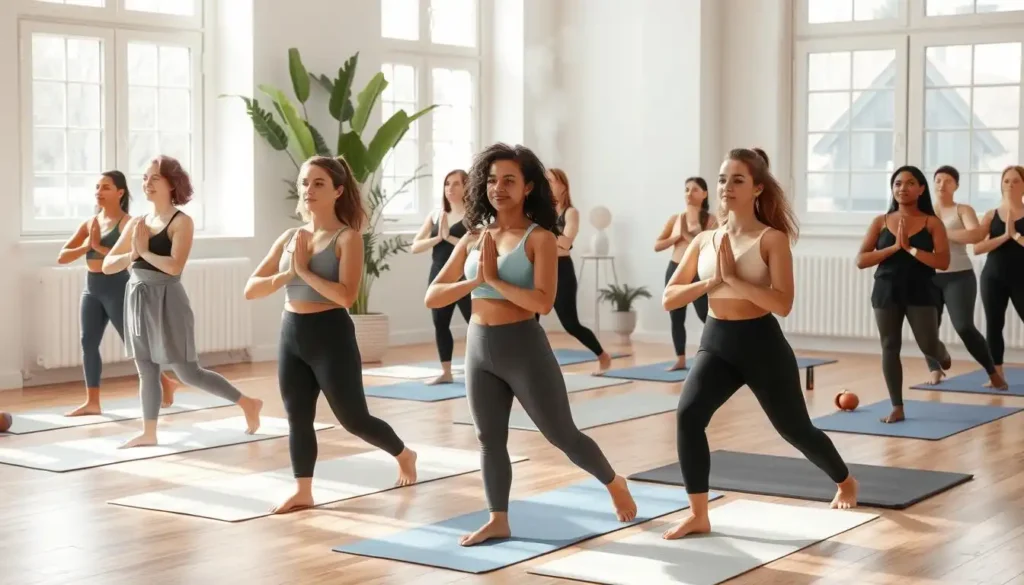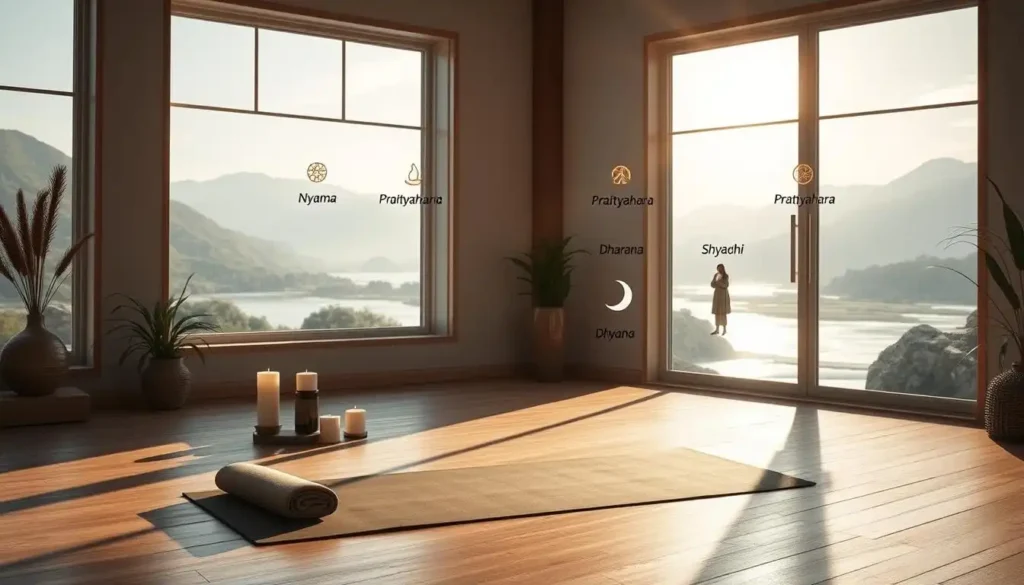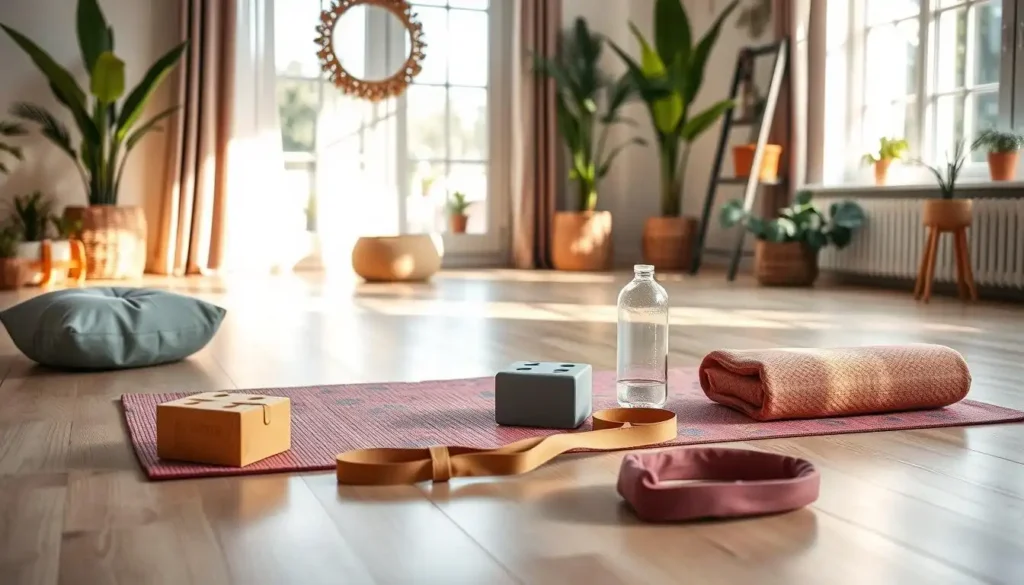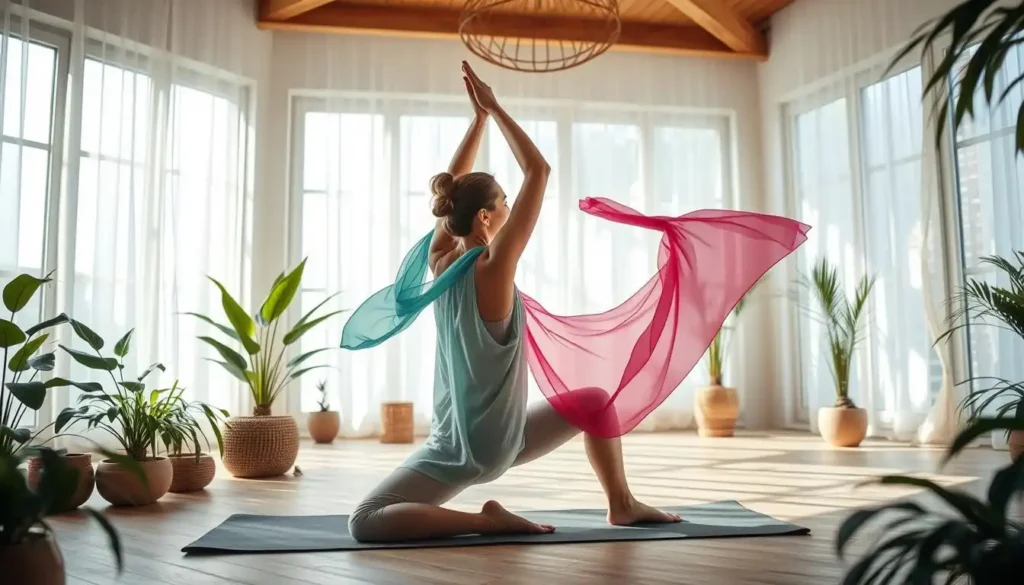Do you know what Yoga is? Let me tell you about it. Nowadays, Yoga is famous all over the world. It is a popular activity that connects body, breath, and mind. Recalling my first yoga experience is so thrilling. My first time on a yoga mat, I felt stiff, my mind was racing, and I wasn’t sure I could find peace. But the moment I took my first deep breath, something changed. This was the start of a journey I’m excited to share with you.
Beginners’ yoga journeys, especially for women, open new doors. It’s not only reaching for your toes or doing hard poses but also a journey about connecting with your body, calming your mind, and finding the unknown strength that you have inside you.

My first seven-day beginner yoga journey with Kassandra Reinhardt taught me the importance of consistency. If you take small steps every day, it can make a huge difference in the end. Each day was full of new challenges and discoveries, which made me more interested in Yoga. My flexibility improved, my stress disappeared, and I felt better from the inside out.
Beginner yoga for women is easy to learn. Regardless of your age, body type, or fitness level, there’s a space for you. Using blocks and straps helps make poses easier, and there are safe ways for everyone to join in.
Beginning yoga takes the test of your patience, but the benefits are unmatchable. You’ll be able to sleep better and feel less pain. Your body will feel light, and you will feel like a free spirit. When you start, remember that every breath and pose is taking you toward a healthier, happier you, which you have never been before.
Key Takeaways
- Yoga is suitable for all ages and body types
- Consistency and patience are crucial in beginning yoga
- Props and modifications make yoga accessible to everyone
- Yoga offers both physical and mental health benefits
- A 7-day beginner yoga journey can kickstart your practice
- Yoga helps reduce stress and improve overall well-being
Introduction to Yoga for Women
Yoga is one of the finest ways for women to improve their physical and mental well-being. From my perspective as a beginner, yoga is welcoming and easy to start with. Now, let’s explore the world of yoga for beginning women and find out why it’s excellent for freshmen.
What is yoga and its origins?
Yoga is an old spiritual practice from India that originated over 3,000 years ago. It mixes physical poses, breathing exercises, and meditation for overall well-being. The word “yoga” means to join together, showing its goal to connect the mind, body, and spirit.
Benefits of yoga for women
Yoga has many benefits for women. It can lower stress, increase flexibility, and help the heart. A 2017 study showed yoga helps with chronic pain, making it a good choice for natural pain relief.
| Benefit | Research Findings |
|---|---|
| Stress Reduction | Older adults felt less stressed after 8 weeks of yoga |
| Pain Management | 20 out of 25 studies found yoga helped with back pain |
| Improved Sleep | Yoga reduces symptoms of depression, anxiety, and stress |
| Mental Health | Yoga reduced symptoms of depression, anxiety, and stress |
Why yoga is perfect for beginners
Yoga is great for beginners because it’s flexible. Beginners can start with easy poses and move at their speed. There are many styles, like gentle Hatha and flowing Vinyasa, so everyone can find one that fits.
“Yoga is the journey of the self, through the self, to the self.” – The Bhagavad Gita
When I started yoga, I noticed a subtle change in my body and mind. It made me feel more transparent and more emotionally balanced. It lets me control myself. Yoga grows with you, making it perfect for women at any age or fitness level.
Read More:10 Essential Yoga Poses for Beginners at Home
Understanding the Principles of Yoga
Yoga is not just a basic routine; it’s a lifestyle. It’s a deep practice based on ancient wisdom. The Yoga Sutras, with 196 aphorisms, guide us in self-discovery. They help you know yourself. Only three of these sutras talk about physical poses or asana.
In gentle yoga, we focus on key principles. You have to look carefully at breathing right; it is the key. Beginners should breathe in and out through the nose and must make the breaths equal. It is called samavati pranayama and is the base of yoga.

Yoga isn’t just about the poses. If so, then you are wrong. It includes bandhas or energy locks. For beginners, learning Mulabandha, Uddiyanabandha, and Jalandharabandha is a must. These locks help improve the effects of yoga poses.
Drishti, or focused gaze, is crucial in yoga. It helps with inner stability and shows you your actual inner state. When you focus on your gaze, you can deepen your practice and become more mindful. According to Judith Hanson Lasater –
“Yoga is not about touching your toes. It’s about what you learn on the way down.” – Judith Hanson Lasater
Yoga’s principles go beyond the physical. Yamas and Niyamas, ethical guidelines. These are the moral bases of yoga. It consists of non-violence, honesty, and self-discipline. They help practitioners live a balanced, mindful life.
| Principle | Description | Benefit |
|---|---|---|
| Asana | Physical postures | Improves flexibility and strength |
| Pranayama | Breath control | Reduces stress, enhances focus |
| Bandhas | Energy locks | Increases energy flow |
| Drishti | Focused gaze | Improves balance and concentration |
| Yamas/Niyamas | Ethical guidelines | Promotes mindful living |
Types of Yoga Suitable for Beginner Women
From my experience, I’ve found that yoga has many styles that are perfect for beginners. Let’s check four popular ones that are amazing for women beginning yoga. Every style has unique benefits for flexibility and stress relief.
Hatha Yoga
Hatha yoga is perfect for beginners. It’s a gentle practice. Focus on basic poses and take deep breaths. It builds strength and flexibility slowly. It’s great for improving flexibility.
Vinyasa Yoga
Vinyasa yoga is another one you can start with. It is a dynamic experience that connects breath with movement, creating a flowing sequence of poses. This style is perfect for cardiovascular fitness and body toning, and it also helps with stress relief.
Yin Yoga
Want to focus on stretching and relaxation? Yin yoga is the key. In this style, poses are generally held for several minutes, targeting connective tissues and increasing flexibility. Those who want to boost their flexibility and find calm can practice this style.
Restorative Yoga
Restorative yoga is all about deep relaxation. It uses props to support the body in comfortable positions for a long time. This style is perfect for stress relief. It also promotes deep relaxation and mental peace.
| Yoga Style | Main Focus | Benefits for Beginners |
|---|---|---|
| Hatha | Basic poses and breathing | Builds strength and flexibility gradually |
| Vinyasa | Flowing sequences | Improves cardiovascular fitness and body toning |
| Yin | Deep stretching | Increases flexibility and promotes relaxation |
| Restorative | Supported relaxation | Relieves stress and enhances mental well-being |
You can’t find a single “best” yoga type. Each style has its benefits, so try different classes and find out which one suits you. Choose according to your needs. You may want yoga for flexibility or stress relief; these styles are great for beginners.
Essential Equipment for Beginner Yoga

At the beginning of a woman’s yoga journey, it does not need much equipment. However, some key items help a lot. You must invest in quality equipment that improves women’s yoga and keeps you motivated to practice regularly.
One thing that is essential is a good yoga mat. You can say it is the most important thing. It is not hard to find. You can find a mat that costs about $20. Though I suggest a premium mat. These cost between $90 and $140 but offer better grip cushioning and last longer. You can call it a good investment if you plan to practice regularly.
Yoga equipment and accessories for beginners are recommended on Amazon.
Yoga blocks are also useful for beginners and advanced yogis. They make your practice safer, help with flexibility, and improve your overall experience. Quality blocks, with wider ones offering more stability, can be found for under $10 each.
- Yoga strap (under $10): Great for stretching and improving flexibility
- Yoga towel: Useful for sweat-inducing styles like power or hot yoga
- Comfortable clothing: Look for breathable, stretchy fabrics
You must pay attention to hygiene! A yoga mat cleaner is a small but essential buy. For comfort, consider a yoga mat sling or bag – prices range from $10 to over $100 depending on style and durability and also your budget
The right equipment can make yoga better. But the most important thing is sustainability. Begin with the basics and add more as your yoga practice grows.
Preparing Your Body and Mind for Yoga Practice
Starting your yoga journey is not just showing up regularly. I’m here to help you set up a suitable space, warm up, and get your mind ready for beginner yoga for women. Our minds do not stay in the same state all the time, so it is important to make up your mind.
Setting up a comfortable space
Your Yoga place must give you a positive vibe. To concentrate, you need a quiet place. So, choose a calm spot in your home where you feel confident, free, and happy. Make sure there’s enough room to stretch fully. Soft lighting, soft music, and calming scents can make the environment better and help you practice better. If you feel comfortable, you will enjoy what you are doing.
Warm-up exercises
Before starting Yoga, warm up. They slowly roll your neck and shoulder shrugs. Then, do arm circles and hip rotations. These moves get your muscles and joints ready for yoga.
Cultivating the right mindset
Your mindset will take you a long way. Focus and believe, take a breath, and stay in the moment. Don’t stress about being perfect—yoga is a journey, not your goal. By practicing every day, you will grow.
| Aspect | Benefit |
|---|---|
| Comfortable Space | Enhances focus and relaxation |
| Warm-up Exercises | Prevents injury and improves flexibility |
| Positive Mindset | Promotes progress and enjoyment |
By setting up a comfortable space, warming up, and focusing your mind, you’re building a strong base for your yoga practice. It will help you to connect your body with your mind. Which yoga is actually about? Embrace the moment and start your journey.
Beginner Yoga for Women: Foundational Poses
Starting your yoga journey can feel overwhelming. But mastering a few poses builds a strong base. As a yoga instructor, I’ve seen many women transform their practice by focusing on these fundamental yoga poses for beginners.
Mountain Pose (Tadasana)
Mountain Pose is the cornerstone of standing poses in female yoga. It helps with your posture and strengthens your legs. Stand tall with feet together, engage your core, and imagine a straight line from your ankles to your head. That’s how you need to practice this pose.
Downward-facing Dog (Adho Mukha Svanasana)
This pose strengthens the upper body and stretches the back. Start on hands and knees, then lift your hips to form an inverted V-shape. Press your heels toward the floor and relax your neck.
Warrior I and II
Warrior poses are for building strength and improving balance. In Warrior I, the first step is to foot back, raise your arms overhead, and bend your front knee. For Warrior II, open your hips and extend your arms parallel to the ground.
Child’s Pose (Balasana)
Balasana, or Child’s pose, is a restful position. It is great for beginners. Kneel on the floor, sit back on your heels, and stretch your arms forward. This pose softly stretches the back and hips and gives relaxation.
Tree Pose (Vrksasana)
Tree Pose increases balance and focus. First, stand on one leg, then place the sole of your other foot on your inner thigh or calf, and bring your hands to the prayer position. This pose strengthens the legs and improves concentration.
| Pose | Benefits | Focus Area |
|---|---|---|
| Mountain Pose | Improves posture, leg strength | Full body alignment |
| Downward-facing Dog | Strengthens upper body, stretches back | Upper body and back |
| Warrior I and II | Builds strength, improves balance | Legs and core |
| Child’s Pose | Promotes relaxation, stretches back and hips | Back and hips |
| Tree Pose | Enhances balance, improves focus | Legs and concentration |
Breathing Techniques for Beginners
Focus on your breathing. It is the core of yoga. As a beginner, I’ve understood that simple breathing techniques change my yoga. These techniques are essential for stress relief and crucial to basic yoga routines.
I will tell you about two easy breathing techniques for beginners: Deep Breathing and Alternate Nostril Breathing. Deep Breathing means taking slow, deep breaths in and out. In this case, I fill and empty my lungs fully. This helps calm my mind and lowers stress.
Alternate Nostril Breathing, or Nadi Shodhana, can feel a bit complex, but trust me, it is helpful. I block one nostril and breathe in through the other, then switch sides to breathe out. This balances my brain’s left and right sides and helps me be more focused and relaxed.
| Breathing Technique | Benefits | Practice Duration |
|---|---|---|
| Deep Breathing | Stress reduction, improved focus | 5-10 minutes daily |
| Alternate Nostril Breathing | Mental balance, anxiety relief | 3-5 minutes daily |
Breathing techniques in my yoga were like a game changer. It helped a lot with stress relief. They’re now inseparable from my daily yoga, keeping me calm and centered.
Creating a Beginner-Friendly Yoga Routine
When you start something new, it is always exciting. Yoga is also the same. But to get good results, you must have a proper routine. I’ll help you make a routine that’s great for beginners. We’ll focus on gentle yoga sequences that help with flexibility and strength.
Sequencing your practice
A typical yoga session goes like this:
- Warm-up exercises (5-10 minutes)
- Standing poses (10-15 minutes)
- Seated poses (10-15 minutes)
- Relaxation and meditation (5-10 minutes)
This order helps you warm up; you can slowly get more intense. Beginners should start with a 5-minute routine, not more than that. It includes five poses, each for 60 seconds.
Balancing strength and flexibility
It’s important to mix yoga for flexibility with strength-building poses. Such as-, the Cobra Pose stretches your chest and abs while strengthening your back. On the other hand, Chair Pose helps build leg and core strength and improves balance.

Incorporating relaxation and mindfulness
Finish your practice with the Corpse Pose (Savasana). It looks so simple, and it’s excellent for relaxation and mindfulness, too. For this, you have to hold this pose for 5 minutes, focus on breathing, and let go of tension.
| Pose | Benefits | Duration |
|---|---|---|
| Downward Dog | Stretches hamstrings and calves; strengthens arms and legs | 60 seconds |
| Cat-Cow | Improves spine flexibility | 60 seconds |
| Warrior II | Builds leg strength, improves balance | 60 seconds (each side) |
| Seated Forward Fold | Stretches back, hamstrings | 60 seconds |
| Corpse Pose | Promotes relaxation, mindfulness | 5 minutes |
Always remember one thing: consistency is the key to success. Practice these gentle yoga sequences often to improve your flexibility and overall well-being.
Common Challenges for Beginner Yogis and How to Overcome Them
Starting yoga is just not exciting. It can be a bit scary if you don’t know the techniques. As a beginner, I’ve faced many obstacles, which you may also face. That’s why I want you to understand what your challenges can be so you can be prepared. Let’s look at these challenges and find ways to beat them.
Flexibility is a big worry for beginners. You can feel down when you can’t touch your toes or do deep stretches. But remember, you can’t master something in one day. It will take time. It’s a journey, not a race. Focus on your daily achievement and celebrate that.
Another big challenge is building strength. Especially in poses like Chaturanga or arm balances. So, the plan is to start with easier versions and slowly move up. Day by day, you will be better at it.
Mental hurdles can be as tough a challenge with physical ones. In the beginning, you will not be perfect. But don’t let that demotivate you. Many beginners find it hard to stay focused and patient. Use mindfulness to keep your mind in the moment. Set realistic goals.
“Yoga is not about touching your toes. It’s about what you learn on the way down.”
Managing your time can be a tough one. Start with short, easy sessions and slowly add more time as you get better. You can start with 5- 10 minutes and gradually increase it.
| Challenge | Solution |
|---|---|
| Flexibility | Use props, focus on progress |
| Strength | Modified poses, consistent practice |
| Mental focus | Mindfulness techniques |
| Time management | Short, regular sessions |
Remember, every yogi started as a beginner. The learning process is to be kind to yourself and enjoy the yoga journey for beginners.
Progressing in Your Yoga Journey
Looking back on my 10-year yoga journey, I see the amazing growth and change it brought. For women starting yoga, the path to getting better is full of chances to deepen their practice. You can explore new parts of yoga.
Advancing to Intermediate Level
Moving up in yoga isn’t just about doing hard poses. It means building a deeper bond with your body and mind. Kate Walker, a famous yoga teacher, taught over 500 people every week in London. According to her words, listening to your breath helps you know when to go further or slow down in poses.
Exploring Different Yoga Styles
As I said before, with time, you will be better. Try different yoga styles to make your practice better. Kate Walker teaches a mix of flow and restorative yoga. She lets her students choose their poses. This is a fantastic idea for those wanting to get more flexible.
Seeking Guidance from Instructors
Experienced teachers can give you great advice to help you move forward safely. In my experience, getting feedback in classes or workshops can change things. It will motivate you. Kate Walker teaches students to make choices that are right for their bodies and needs, essential for getting better at yoga.
| Aspect | Beginner | Intermediate |
|---|---|---|
| Focus | Learning basic poses | Refining alignment and breath |
| Practice frequency | 1-2 times per week | 3-4 times per week |
| Class duration | 30-60 minutes | 60-90 minutes |
| Pose difficulty | Foundational poses | More challenging variations |
Yoga progress is personal and different for every person. It’s not about being perfect in poses. It’s about understanding your body and mind better and making connections between them. Take each step of your journey carefully and enjoy it. You will find that yoga offers new challenges and rewards.
Conclusion
Beginner yoga for women is a journey of self-discovery, finding inner peace and well-being. I’ve looked into how to start yoga, from its basics to mastering simple poses. Yoga is excellent for everyone. Anyone at any age can start it, regardless of age or fitness level. You can start it at any time.
Practice regularly. You can try Hatha, Vinyasa, Yin, or Restorative yoga; each style has benefits. Be patient with yourself. With time, you will be more robust and flexible in your body and mind. So, make a cozy place for yourself, take your yoga mat out, take a deep breath, and start a new journey to explore a new world with yoga.
“This article is not medical advice. Always speak to a medical professional before starting any new exercise regimen to ensure it is right for you. This post may contain affiliate links.”






